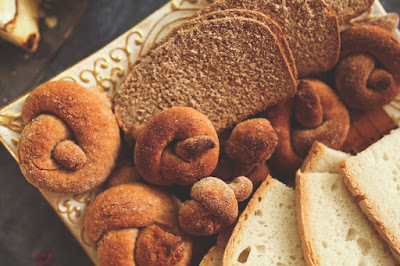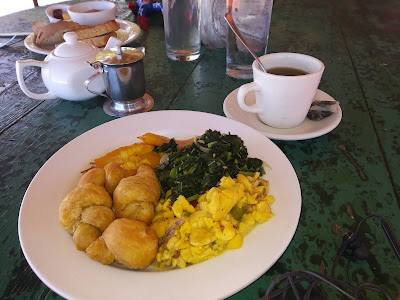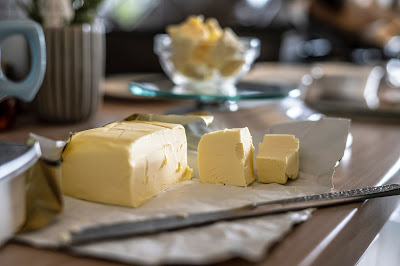Monday, February 28, 2011
Before I take another drink-The Calories in Alcohol
Wednesday, February 23, 2011
Why is Flour so expensive?
The majority of our diet includes a lot of flour and flour-based products, from our boiled and fried dumplings to our bread, bulla, bun, and crackers.
These foods are included in our Staples food group. What are we going to do when this price increase takes place??
Sunday, February 20, 2011
Planning a Day's Meal
Saturday, February 19, 2011
Eating to Survive - Fats Macro-Nutrient
| Olive Oil |
Fat is a source of energy, you can get a lot of energy from a small amount of fat. There are varieties of food that we can get fat from. There are good fats and bad fats however, for today's post we just want to cover why we need fats in our diet at all.
Eating to Survive - Protein macro-nutrient
The main function of Protein is to aid in the growth and repair of the body. Aside from water, protein is the most abundant molecule in the body. Protein is found in all cells of the body and is the major structural component of all cells in the body, especially muscle. This also includes body organs, hair, and skin. Hormones and enzymes are also formed from amino acids in which help regulate metabolism, support the immune system and other body functions. Finally, protein is needed to form blood cells. Wikipedia
The many Benefits of Drinking Tea
Tea is an aromatic beverage commonly prepared by pouring hot or boiling water over cured or fresh leaves of Camellia sinensis, an evergreen shrub native to East Asia.[3] After water, it is the most widely consumed drink in the world.
In Jamaica, any warm beverage is considered tea, therefore, we consider warm Milo, Mint, Peppermint, Horlicks, as well as the rightly named Tea, to be tea. Tea as known worldwide is the brew of the leaves of the Chinese Camellia sinensis.
1.Tea contains antioxidants. Like the Rust-Oleum paint that keeps your outdoor furniture from rusting, tea's antioxidants protect your body from the ravages of aging and the effects of pollution.
2. Tea has less caffeine than coffee. Coffee usually has two to three times the caffeine of tea (unless you're a fan of Morning Thunder, which combines caffeine with mate, an herb that acts like caffeine in our body). An eight-ounce cup of coffee contains around 135 mg caffeine; tea contains only 30 to 40 mg per cup. If drinking coffee gives you the jitters, causes indigestion or headaches, or interferes with sleep switch to tea.
3. Tea may reduce your risk of heart attack and stroke. Unwanted blood clots formed from cholesterol and blood platelets cause heart attack and stroke. Drinking tea may help keep your arteries smooth and clog-free, the same way a drain keeps your bathroom pipes clear. A 5.6-year study from the Netherlands found a 70 percent lower risk of a fatal heart attack in people who drank at least two to three cups of black tea daily compared to non-tea drinkers.
4. Tea protects your bones. It's not just the milk added to tea that builds strong bones. One study that compared tea drinkers with non-drinkers, found that people who drank tea for 10 or more years had the strongest bones, even after adjusting for age, body weight, exercise, smoking, and other risk factors. The authors suggest that this may be the work of tea's many beneficial phytochemicals.
5. Tea gives you a sweet smile. One look at the grimy grin of Austin Powers and you may not think drinking tea is good for your teeth but think again. It's the sugar added to it that's likely to blame for England's bad dental record. Tea itself actually contains fluoride and tannins that may keep plaque at bay. So add unsweetened tea drinking to your daily dental routine of brushing and flossing for healthier teeth and gums.
See Ivillage health the rest of the benefits of Tea
Monday, February 14, 2011
Eating to Survive - Carbohydrates Macro-Nutrient
Carbohydrates are manufactured by plants and are a major source of energy in the diet and should amount to around half of the total calories.
Carbohydrates are found in many forms; simple sugars like glucose (which is the basic sugar unit), fructose (found in fruits), complex carbohydrates such as lactose (found in milk), and cellulose (found in plants).
"Carbohydrates are one of three main nutrients in food, the others being fats and protein. There are three common types of carbs in foods: Sugar, Starch, and Dietary fiber. Only sugar and starch is digested, as the human body lacks the digestive enzymes to break down (metabolize) dietary fiber in the intestinal tract."
"Sugar-carbs are found in a range of natural food, including milk (containing lactose, or milk sugar), fruits (containing fructose, or fruit sugar) and sugar beet (containing sucrose)."
"Starch-carbs are found in all cereal grains, as well as roots and tubers. Starchy foods include bread, pasta, rice, noodles, couscous, tapioca, potatoes, sweet potatoes, and yams."
"Dietary fiber carbohydrates (soluble and insoluble fiber) are found in most plant foods, like fruits and vegetables, legumes and whole-grain cereals."
What does this all mean, it means that these foods contain energy. Carbohydrates when broken down become energy for the body to use. There is no way of effectively eliminating carbohydrates from the diet, which is why a low carbohydrate diet is not effective.
Carbohydrates should make up the largest percentage of energy that we get from foods because this is the form in which the body uses energy most readily, especially our brain.
What is effective however is portion control. By using the guides given earlier in the Eating to Survive series you can see what a serving of each of these food groups is.
This series is slowly building towards showing you the reader how to organize a day's meal based on what you have and still meeting your daily requirements.
Did you enjoy this article? Please comment.
Thursday, February 10, 2011
The Benefits of Having a Proper Breakfast
Breakfast is the first meal that you have at the start of the day as it breaks the fast your body takes during sleep.
Most of the time we refer to breakfast we are thinking of the first meal we eat in the mornings after a night’s rest. Breakfast is the first meal that you have at the start of the day as it breaks the fast your body takes during sleep. A fast is usually voluntary abstinence from food or drink, especially as a religious duty, but we use the term to describe going for a certain length of time without eating anything and our seven to ten hours of sleep would be seen as a period of fasting. Most people sleep at night and are active during the day, but this is not always the case. For this reason, this post will be about the first meal you consume after a period of rest, and how its content can give you a boost to have a productive day.
Monday, February 7, 2011
Calories and their Effects on our Weight
In recent years we have seen an increase in the populations' health consciousness and general awareness of our diet and activity level in determining the quality and length of our lives. This has led to the introduction of buzzwords to help us to understand and control how to approach dieting. One of these buzzwords is Calorie. We hear about it every day, but what are calories? A calorie is a unit that measures the energy content in the food we eat.
Calories are what our bodies need to function, if we restrict calories too much we will starve and if we consume too many calories consistently without burning them with physical activity, we will become overweight/obese. A balanced diet is one where we consume the right number of calories required for our bodies to function effectively. This is usually 1500-3000 Kcal per day.
Saturday, February 5, 2011
Value shopping in Jamaica
There are not many "sales", for anything at all, nor are there any real bargains. Whenever stores claim to be having a sale there is usually not much different from general shopping prices.
Everyone loves a bargain, however sadly in Jamaica there aren't many places that offer these.
I have been to supermarkets and found the coupons for essential items as well as some items that no one would normally purchase in some obscure corners, or hidden under mountains of other items. What is achieved by doing this?
I grew up watching a lot of Cable TV, and I have always seen the sales and bargains that are offered everywhere on my television. This does not take place in Jamaica. Jamaicans are very kind people, however this does not seem to be reflected by corporate Jamaica.
There are not many "sales", for anything at all, nor are there any real bargains. Whenever stores claim to be having a sale there is usually not much different from general shopping prices.
In the past two weeks I have seen the Ministry of Agriculture make two separate attempts at hosting a Farmers market. This is very encouraging for me as a nutrition professional because it signifies that IF this trend is maintained, we will be able to buy Jamaican goods in surplus and at cheaper rates. This is good for our very hardworking farmers and also Jamaicans who are now a step closer to achieving some amount of food security. I applaud the effort and hope it takes off in every parish of this country.
Did you like this article? Please comment.
Eating to Survive - Fats and Oils Food Group
"Fats in our diets serve as a major source of energy, that also helps your bodies to absorb the fat-soluble vitamins and minerals needed to maintain and repair cells damaged during everyday wear and tear. It is also needed to generate cell membranes and the sheath surrounding nerves. It is also essential for blood clotting, muscle movement, and inflammation."
| Oils |
Fats and Oils foods are required in the diet in order to classify it as a balanced one, therefore we cannot eliminate them from our diets. Additionally, even when not consumed directly, they are still present in foods from other food groups, etc. Legume, and Foods from Animals. We need fats in our diets because it is a major source of energy that helps your body to absorb fat-soluble vitamins and minerals that help in the maintenance and repair due to everyday wear and tear. It is also needed to generate cell membranes and the sheath surrounding nerves. It is also essential for blood clotting, muscle movement, and inflammation. For long-term health, some fats are better than others. Good fats include monounsaturated and polyunsaturated fats. Bad ones include industrial-made trans fats. Saturated fats fall somewhere in the middle.
Monounsaturated fats are usually liquid at room temperature and are usually found in olive oil, peanut oil, canola oil, avocados, and most nuts, as well as high-oleic safflower and sunflower oils.
Corn oil, sunflower oil, and safflower oil are common examples. Polyunsaturated fats are essential fats. That means they're required for normal body functions but your body can't make them. So, you must get them from food. Polyunsaturated fats are used to build cell membranes and the covering of nerves. They are needed for blood clotting, muscle movement, and inflammation.
Good sources of omega-3 fatty acids include fatty fish such as salmon, mackerel, and sardines, flaxseeds, walnuts, canola oil, and non-hydrogenated soybean oil.
Omega-3 fatty acids may help prevent and even treat heart disease and stroke. In addition to reducing blood pressure, raising HDL, and lowering triglycerides, polyunsaturated fats may help prevent lethal heart rhythms from arising. Foods rich in linoleic acid and other omega-6 fatty acids include vegetable oils such as safflower, soybean, sunflower, walnut, and corn oils.
Here are the foods in this group that we have in the Caribbean and the recommended serving sizes.
| FATS AND SUBSTITUTES | MEASURE/EXCHANGE |
| UNSATURATED FATS | |
| Margarine | 1 tsp |
| Avocado | 1/8 (10 cm diameter) |
| Ackee (Jamaica) | 2 seeds |
| Peanut butter | 1 tsp |
| Peanuts | 10 only |
| Cashew Nuts | 4 only shelled |
| Olives, green** | 5 small |
| Almonds (dry roasted) | 6 whole |
| Oil (corn, cottonseed, safflower, sunflower, olive, soybean, peanut) | 1 tsp |
| Salad dressing, mayonnaise type | 1 tsp |
| Salad dressing (all varieties)** | 1 tbsp. |
| Salad dressing (reduced-calorie)*** | 2 tbsp. |
| SATURATED FATS | |
| Butter | 1 tsp |
| Lard | 1 tsp |
| Shortening | 1 tsp |
| Ghee | 1 tsp |
| Bacon, streaky without rind | Small rasher |
| Bacon fat** | 1 tsp |
| Chicken fat | 1 tsp |
| Pork salted** | 2½ cm cube |
| Cream cheese | 1 tbsp. |
| Coffee whitener powder | 4 tsp |
| Oil (coconut and palm) | 1 tsp |
| Coconut (dried, grated) | 2 tbsp. |
We will be discussing macro-nutrients and their benefits to the diet.
Your turn now, feel free to comment. Do you think fats are bad?
Friday, February 4, 2011
Eating to Survive - Vegetables Food Group
"Vegetables provide our bodies with vitamins, minerals, and dietary fiber and can be really tasty and fun."
Vegetables are the edible parts of plants consumed as food, for example, flowers, fruits, stems, leaves, roots, and seeds. Vegetables provide our bodies with vitamins, minerals, and dietary fiber and can be really tasty and fun. Here in the Caribbean, this group encompasses all foods that are dark green leafy, yellow, and other non-starchy vegetables.
As a tropical island, the Jamaican diet is filled with a variety of fresh vegetables as we have easy access to crops from home gardening and commercial farming. However, although we have access to vegetables we are still not consuming the recommended five servings per day of vegetables even though we are encouraged to do so. We do have access to mainly organic produce due to the size of the country and our current farming practices and we do tend to take this for granted.
Here is a list of the vegetables we consume in the Caribbean and the measurement we use to determine a serving. well as the amount we refer to as servings.
DARK GREEN LEAFY, YELLOW, AND OTHER STARCHY VEGETABLES | MEASURE/EXCHANGE |
GREEN LEAFY AND OTHER LOW-CALORIE VEGETABLES | |
Baghi | Vegetables such as those listed in this group may be used as desired if raw, as they do not have much energy. When cooked use only 1 cup. You may use these vegetables at each meal in addition to your other vegetable allowance. |
Bamboo shoots | |
Cabbage | |
Callaloo bush (Dasheen leaves, Aramanthus) | |
Carailli | |
Cauliflower | |
Celery | |
Chives/green seasoning | |
Christophene/Chocho | |
Cress/Criches/Cressles | |
Cucumber | |
Kale | |
Lettuce | |
Melongene/Eggplant/Aubergine/Baigan | |
Mustard greens | |
Okra | |
Pak Choy/Bok Choi/Chinese Cabbage | |
Pawpaw, green | |
Spinach | |
Squash (Cucumber type) | |
Tomato | |
YELLOW AND OTHER VEGETABLES | |
Beetroot | ½cup |
Bodi | ¾cup |
Carrot | ½cup |
Chow Mein (Chinese vegetables) | ½ cup |
Mixed vegetables, canned | ½ cup |
Onions | 1 medium or 2 small or ½ cup |
Pumpkin | ½cup |
String beans, salad beans (immature pod) | ¾ cup |
Turnip | ½cup |
The next post will be a breakdown of the Fats and Oils food groups. As promised, we will then put all this information together to get a better understanding of meal planning and what it means to truly eat to survive.
Did you like this article? Please comment












